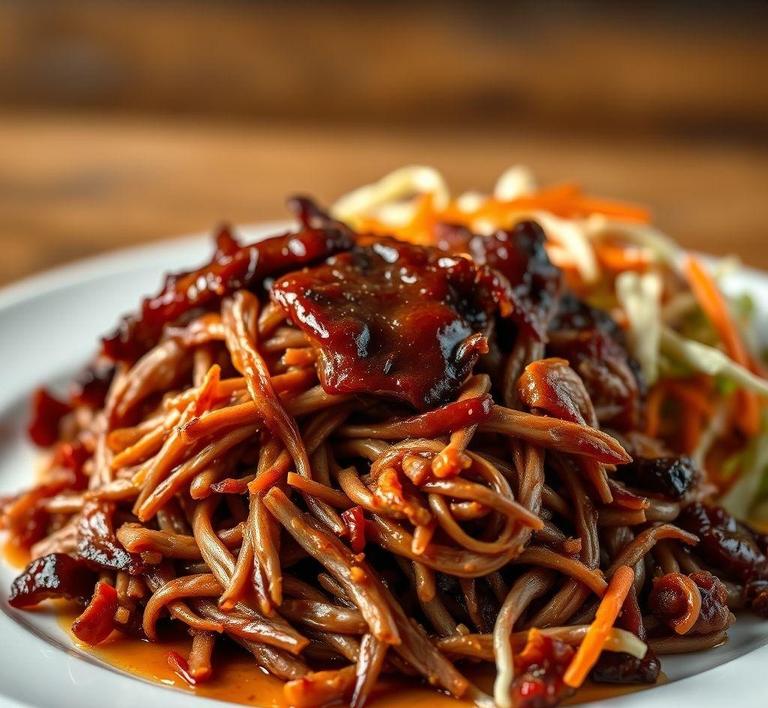Refreezing pulled pork is a great way to extend the life of your delicious leftovers, but there are some important things to keep in mind to preserve its taste and texture. While you can certainly freeze pulled pork after it’s been cooked, it’s best to refreeze it only once and under specific conditions. Properly storing it in airtight containers or freezer bags, and ensuring it’s cooled down to room temperature before freezing, will help maintain its juicy, tender goodness when reheated. In this guide, we’ll walk you through the step-by-step process of safely refreezing pulled pork, so you can enjoy that smoky, flavorful goodness long after the initial meal.
Can You Refreeze Pulled Pork?

Refreezing pulled pork might seem like a good way to extend its shelf life, especially when you’ve made a large batch or have leftovers from a meal. The short answer is: Yes, you can refreeze pulled pork, but there are several important considerations to keep in mind regarding the quality, safety, and texture of the meat after it’s been frozen, thawed, and refrozen.
When pulled pork is first cooked and frozen, it retains most of its flavor and texture, provided it is frozen properly. However, when it is thawed and refrozen, certain changes in its quality and safety can occur that you should be aware of. The more times meat is frozen and thawed, the greater the risk of bacterial growth, which could lead to foodborne illness. Also, repeated freezing and thawing can cause changes in the texture and moisture content of the pulled pork, making it less appealing once reheated.
In the case of pulled pork, the process of cooking, pulling the pork, and freezing it initially all play into how well it can tolerate being refrozen. The key is to focus on how quickly the pulled pork is thawed and refrozen, how well it’s stored, and how many times it goes through this process. Refreezing pulled pork isn’t inherently dangerous, but it does carry risks that must be carefully managed.
How To Refreeze Pulled Pork?
If you’ve decided to refreeze your pulled pork, there are specific steps you need to follow to ensure that the pork stays safe to eat and retains as much of its original flavor and texture as possible. Here’s how to do it:
1. Proper Thawing
The first step in refreezing pulled pork is to make sure the pork has been thawed correctly. If you’re taking it out of the freezer to use it, avoid thawing it at room temperature, as this creates an environment in which bacteria can grow. The safest ways to thaw pulled pork are:
- In the refrigerator: This is the safest method, but it can take up to 24 hours depending on the size of the pork. Thawing slowly in the fridge keeps the pork at a safe temperature.
- In cold water: If you’re in a rush, you can place the pulled pork in an airtight bag and submerge it in cold water. Change the water every 30 minutes to keep it cool. This method works faster but requires attention.
- In the microwave: For smaller portions, you can use the defrost function of the microwave. However, this method might partially cook the pork, which affects the texture.
2. Cooling Before Refreezing
After the pulled pork has been thawed and used, you’ll need to cool it down completely before refreezing. Hot food should not be placed directly into the freezer, as this can increase the temperature of the freezer and affect other items stored inside. Allow the pulled pork to cool down to room temperature (but no longer than 2 hours), then place it in an airtight container or freezer-safe bag. It’s crucial to remove as much air as possible from the storage bag to prevent freezer burn, which occurs when air exposure dries out the food.
3. Packaging And Storing
After the pulled pork has cooled, store it in a manner that protects it from air and moisture. Use heavy-duty freezer bags or airtight containers, and consider double-bagging it for extra protection. Label the bags or containers with the date so you can keep track of how long the pork has been in the freezer.
4. Freezing Quickly
Once it’s packed up, place the pulled pork in the coldest part of the freezer. The quicker the pork freezes, the better it will maintain its quality. Freezing at a lower temperature helps to preserve the texture and flavor by locking in moisture more effectively.
Quality Impact
The quality of refrozen pulled pork will inevitably degrade over time, and this impact is more noticeable with each freeze-thaw cycle. The key elements affected by refreezing pulled pork are texture, moisture retention, and flavor. Here’s how these elements can change:
1. Texture Changes
Pulled pork, by nature, already has a shredded texture that is tender and juicy when fresh. When the pork is frozen and then thawed, ice crystals form inside the meat’s cells. These ice crystals can rupture the cell walls, leading to a loss of moisture during the thawing process. As a result, the texture can become more dry and stringy when reheated. If you refreeze the pork, this moisture loss is compounded, and the pulled pork might become even drier and less tender.
The fibrous nature of the pork can make this effect more noticeable, and while reheating in a sauce or adding extra liquid can help mitigate the dryness, it won’t restore the meat to its original condition.
2. Flavor Loss
Freezing pulled pork doesn’t significantly alter its flavor initially, but each freeze-thaw cycle can cause the pork to lose some of its savory depth. Freezing leads to the breakdown of some of the volatile compounds that contribute to the flavor, and the fat content may become less aromatic. Additionally, the sauces or seasonings used in the pulled pork might break down or separate during the freezing process, affecting the flavor profile.
Refrozen pulled pork, especially after multiple cycles, may taste slightly more bland or "stale" compared to freshly cooked pork.
3. Moisture Loss
As mentioned, the process of freezing and thawing pork leads to moisture loss. This is often the most significant issue with refrozen pulled pork. The key to reducing moisture loss is ensuring that the pork is packed tightly, in a vacuum-sealed bag or tightly sealed container, and not stored for too long before being used again. Adding a small amount of broth or sauce when reheating can help to regain some of the lost moisture, but the pork will never be as juicy as it was initially.
Refreezing pulled pork is possible, but it’s not ideal. While it’s safe to do so as long as you follow proper thawing, cooling, and packaging procedures, it will inevitably affect the quality of the meat. The texture and flavor will suffer, with the pork becoming drier, stringier, and less flavorful each time it’s frozen and thawed. If you absolutely must refreeze pulled pork, try to limit the number of times it goes through the freeze-thaw process, and make sure it’s stored as securely as possible to reduce moisture loss and freezer burn.
For the best results, plan ahead by only freezing pulled pork once and using it within a few months. If you do find yourself with leftovers that you intend to refreeze, consider using the pulled pork in recipes like soups, stews, or casseroles where the moisture and texture loss will be less noticeable. But if you can, enjoy your pulled pork fresh or only frozen once to retain its peak flavor and texture.
Is It Safe To Refreeze Pulled Pork?
Refreezing pulled pork-or any cooked meat for that matter-can be a controversial subject when it comes to food safety. The general consensus is that, yes, it is possible to refreeze pulled pork, but it comes with important caveats. The primary concern revolves around how the pork is handled during the process of freezing, thawing, and refreezing. When you freeze pulled pork, it goes through a series of temperature changes that can affect its quality and safety.
The USDA guidelines state that as long as the pork is safely thawed in the fridge and hasn’t been left at room temperature for too long (no more than 2 hours), it can be safely refrozen. This is because the low temperature slows down bacterial growth, preventing harmful pathogens from multiplying. However, if the pork has been thawed on the counter or in warm conditions, it should not be refrozen, as this could lead to foodborne illness.
When refreezing pulled pork, it is essential to do so within 3 to 4 days of thawing, as after that time, the quality and safety can be compromised. The best method to refreeze is by wrapping the pulled pork tightly in an airtight container or freezer-safe bag to prevent freezer burn, which can degrade the flavor and texture.
It’s also worth noting that while it’s safe to refreeze the pork, repeated freezing and thawing can affect the texture, making the meat drier and tougher due to moisture loss. For the best results, it’s advisable to only refreeze pulled pork once to maintain the best possible taste and texture.
Signs That Pulled Pork Should Not Be Refrozen
While refreezing pulled pork can be safe if done properly, there are several warning signs that should make you rethink your decision. If any of these apply, it’s better to err on the side of caution and discard the meat to avoid foodborne illness:
- Soured or Off-Smelling Pork: If your pulled pork has a rancid, sour, or off-putting smell, it’s a clear indication that it’s gone bad. A pungent odor is usually a sign that bacteria or mold has started to break down the meat. This is one of the most obvious signs that it should not be refrozen, or even consumed.
- Slimy Texture: When meat begins to spoil, it can develop a slippery or slimy texture on its surface. This happens as bacteria break down the proteins in the pork. If you notice any sliminess, discard the pork immediately.
- Discoloration: If the pulled pork has changed from a rosy pink or tan color to grayish or brownish hues, it could indicate bacterial growth or oxidation. While some color changes can be normal due to exposure to air, drastic discoloration should be a red flag.
- Presence of Ice Crystals or Freezer Burn: If the pork has ice crystals throughout or visible freezer burn (discolored, dried-out areas), this indicates that it’s been in the freezer for a long time or wasn’t stored properly. Freezer burn can affect the taste and texture, making it unappetizing, and although it won’t make you sick, it’s a sign that the pork has suffered quality loss.
- Thawing and Refreezing Multiple Times: If you’ve already thawed and refrozen the pulled pork more than once, the meat is likely to have lost its quality and may have begun to harbor harmful bacteria. The more often you freeze and thaw meat, the more opportunities bacteria have to proliferate.
Common Refreezing Mistakes
When it comes to refreezing pulled pork, there are a few common mistakes people often make that can compromise food safety and quality. Let’s break down these missteps and how to avoid them:
- Thawing at Room Temperature: One of the most dangerous mistakes is leaving pulled pork out at room temperature to thaw. While it may seem convenient to speed up the process, this practice allows the pork to enter the “danger zone” (between 40°F and 140°F), where bacteria can multiply rapidly. Always thaw pulled pork in the refrigerator, which keeps it at a safe, constant temperature. If you’re short on time, you can also thaw it using the microwave or in cold water, but never leave it on the counter.
- Refreezing Without Proper Packaging: Another common error is not properly sealing the pulled pork before refreezing. If you just toss the pork in a regular container or leave it uncovered, air and moisture will cause freezer burn, drastically affecting both the texture and flavor. Make sure to wrap the pulled pork tightly in a freezer-safe bag, or place it in an airtight container to protect it from air exposure and prevent freezer burn.
- Refreezing After It’s Been Left Out Too Long: If the pulled pork has been sitting out for more than 2 hours, or if you’re unsure about how long it was at room temperature, it’s best not to attempt to refreeze it. The meat may have entered the danger zone, and refreezing it could trap harmful bacteria inside. Always err on the side of caution with food safety.
- Not Considering the Meat’s Initial Quality: Sometimes people forget that the quality of the pork when it was first cooked plays a role in the final result after refreezing. If the pork was already overcooked or of low quality, freezing and refreezing will only exacerbate any issues with dryness or toughness. For the best results, ensure your pulled pork is fresh and well-cooked before freezing in the first place.
- Refreezing Larger Portions Without Dividing: If you freeze a large portion of pulled pork without dividing it into smaller servings, you risk having to thaw and refreeze the entire batch every time you want a meal. This repeated freezing and thawing will lead to a deterioration in taste and texture. Instead, portion out the pulled pork into meal-sized servings before freezing.
Tips And Tricks For Refreezing Pulled Pork
If you want to maximize the quality and safety of refrozen pulled pork, here are some tips and tricks to follow:
- Cool the Pork Quickly: Before freezing, make sure the pulled pork cools down quickly to prevent bacterial growth. You can place the pork in a shallow pan and leave it uncovered in the refrigerator for several hours to speed up the cooling process.
- Use Vacuum Sealing: If you have a vacuum sealer, it’s a great tool for preserving pulled pork in the freezer. Vacuum sealing removes air from the packaging, reducing the risk of freezer burn and preserving the meat’s moisture. This helps keep the pulled pork juicy and flavorful when it’s thawed.
- Label and Date: Always label your freezer bags or containers with the date that you froze the pulled pork. This will help you keep track of how long it has been stored and ensure that you use it within a reasonable time frame, typically 3-4 months for best quality.
- Portion Control: Divide the pulled pork into smaller portions before freezing. That way, you can thaw only what you need, reducing the number of times the pork is exposed to the thaw-freeze cycle.
- Reheat Safely: When you’re ready to eat the refrozen pulled pork, ensure that it’s reheated thoroughly. Use a food thermometer to make sure it reaches at least 165°F to kill any harmful bacteria that might have developed.
- Consider Sauces and Seasonings: If you know you’re going to freeze the pulled pork, consider adding extra sauce or moisture before freezing. This can help mitigate the dryness that often results from freezing and thawing. The added moisture will help maintain the tenderness and flavor.
Conclusion
Refreezing pulled pork can be a convenient way to extend the shelf life of leftovers, but it requires careful handling to ensure that it remains both safe and enjoyable to eat. The key to successfully refreezing pulled pork lies in proper thawing, packaging, and timing. By following food safety guidelines, avoiding common mistakes, and applying a few helpful tricks, you can minimize the risk of bacterial contamination and preserve the quality of your pulled pork for future meals.
Remember, while refreezing is generally safe if done correctly, it can affect the texture and flavor of the meat. To preserve its best qualities, try to limit refreezing to one time and follow the best practices for storage and reheating. With these tips, you can enjoy pulled pork at its best, even after freezing and refreezing.


